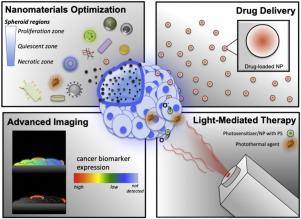Applied Materials Today ( IF 8.3 ) Pub Date : 2020-01-09 , DOI: 10.1016/j.apmt.2019.100552 Ana Katrina Mapanao , Valerio Voliani

|
Three-dimensional tumor models are becoming extensively employed in cancer research due to their accessibility and close representation of physiological tumor conditions. Hence, novel oncological diagnostic, therapeutic and combined theranostic platforms, including nanomaterial-based systems, are increasingly evaluated at preclinical stage by means of such models.
Here, we provide an overview of the functional features and methods of preparation of some of the most interesting 3D tumor models, with a special attention to the classical and widely utilized multicellular tumor spheroids. Their applications in nanomaterial biosafety and efficacy assessment are highlighted, along with the suitable evaluating techniques. Overall, this review comprehensively illustrates the significant role of 3D tumor models towards the translation of nanomaterials to clinics. Their inclusion in biomedical and preclinical research workflow may address the issues related to both the conventional two-dimensional cell cultures and animal models, ultimately promoting breakthroughs in cancer nanotheranostics research.
中文翻译:

三维肿瘤模型:促进纳米热学转化研究的突破
三维肿瘤模型由于其可访问性和生理肿瘤状况的紧密表示而正被广泛用于癌症研究。因此,借助于这种模型,在临床前阶段越来越多地评估包括基于纳米材料的系统在内的新型肿瘤学诊断,治疗和联合治疗学平台。
在这里,我们提供了一些最有趣的3D肿瘤模型的功能特征和制备方法的概述,并特别关注了经典且广泛使用的多细胞肿瘤球体。重点介绍了它们在纳米材料生物安全性和功效评估中的应用以及合适的评估技术。总的来说,这篇综述全面地说明了3D肿瘤模型在纳米材料到临床翻译中的重要作用。将它们包括在生物医学和临床前研究工作流程中可能会解决与常规二维细胞培养和动物模型有关的问题,最终促进癌症纳米热学研究的突破。


























 京公网安备 11010802027423号
京公网安备 11010802027423号